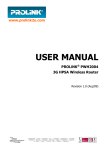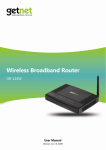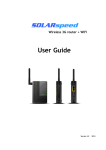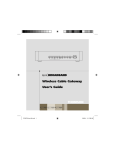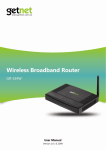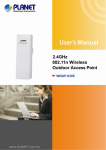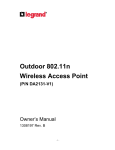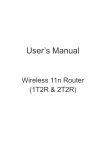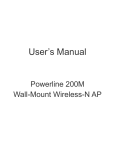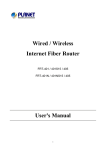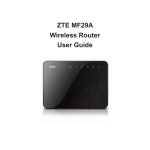Download Wireless Access
Transcript
Wireless 802.11b/g/n
Portable Router
User’s Manual
Federal Communication Commission
Interference Statement
This equipment has been tested and found to comply with the limits for a Class B digital device,
pursuant to Part 15 of the FCC Rules. These limits are designed to provide reasonable protection
against harmful interference in a residential installation. This equipment generates uses and can
radiate radio frequency energy and, if not installed and used in accordance with the instructions,
may cause harmful interference to radio communications.
However, there is no guarantee that interference will not occur in a particular installation. If this
equipment does cause harmful interference to radio or television reception, which can be
determined by turning the equipment off and on, the user is encouraged to try to correct the
interference by one or more of the following measures:
Reorient or relocate the receiving antenna.
Increase the separation between the equipment and receiver.
Connect the equipment into an outlet on a circuit different from that to which the receiver is
needed.
Consult the dealer or an experienced radio/TV technician for help.
Warning: Changes or modifications to this unit not expressly approved by the party responsible
for compliance could void the user authority to operate the equipment.
This device complies with Part 15 of the FCC Rules. Operation is subject to the following two
conditions: (1) this device may not cause harmful interference, and (2) this device must accept any
interference received, including interference that may cause undesired operation.
The user’s manual or instruction manual for an intentional or unintentional radiator shall caution the
user that changes or modifications not expressly approved by the party responsible for compliance
could void the user’s authority to operate the equipment.
CAUTION:
1. To comply with FCC RF exposure compliance requirements, a separation distance of at least 20 cm
must be maintained between the antenna of this device and all persons.
2. This Transmitter must not be co-located or operating in conjunction with any other antenna or
transmitter
Table of Content
CHAPTER 1: INTRODUCTION..............................................................................1
Features......................................................................................................................................... 1
Physical Details........................................................................................................................... 1
CHAPTER 2: ABOUT OPERATION MODES .......................................................3
Operation Modes ........................................................................................................................ 3
Access Point Mode ..................................................................................................................... 3
Gateway Mode ............................................................................................................................ 4
Client Mode .................................................................................................................................. 5
CHAPTER 3: CONFIGURATION ...........................................................................6
Hardware Connection............................................................................................................... 6
Login ............................................................................................................................................... 6
Wizard (GW) .............................................................................................................................. 10
Internet Settings...................................................................................................................... 15
Wireless Settings ..................................................................................................................... 23
Firewall (GW) ............................................................................................................................ 47
Administrator ............................................................................................................................ 54
CHAPTER 4: PC CONFIGURATION .................................................................59
Overview ..................................................................................................................................... 59
Windows Clients....................................................................................................................... 59
Macintosh Clients..................................................................................................................... 63
Linux Clients .............................................................................................................................. 63
Other Unix Systems................................................................................................................. 64
Wireless Station Configuration ........................................................................................... 64
APPENDIX A: TROUBLESHOOTING.................................................................65
Overview ..................................................................................................................................... 65
General Problems..................................................................................................................... 65
Internet Access......................................................................................................................... 65
Wireless Access ........................................................................................................................ 66
APPENDIX B: ABOUT WIRELESS LANS..........................................................68
BSS ................................................................................................................................................ 68
Channels...................................................................................................................................... 68
Security........................................................................................................................................ 68
Wireless LAN Configuration ................................................................................................. 69
Chapter 1:
Introduction
This is a compact/travel size IEEE802.11b/g/n router with 2 fast Ethernet ports, which provides a
powerful high-speed wireless connection for compatible wireless-enabled devices into the network
with the freedom to roam. With web-based UI, this Access Point is easy to be setup and maintained.
All functions can be configured within the easy and friendly user interface via web browser. Via the
fast wireless network speed up to 150 Mbps, you can be very comfortable to have experience of high
speed web surfing, files downloading, online game playing, and video conference session and
streaming high quality multimedia materials. The Wireless Portable Router provides WPA/WPA2,
64/128 bit WEP encryption and IEEE802.1x which ensures a high level of security to protect users’
data and privacy when you are traveling.
Features
•
•
•
•
•
•
•
Create temporary, personal, wireless access in your hotel room or a coffee shop hotspot
Travel size design with selectable extra 2dBi high gain dipole antenna to enhance performance
High security with build-in: WEP 64/128, WPA, WPA2 mixed, 802.1x and 802.11i
Support AP,Gateway and Client Mode
Wireless Quality of Service (QoS) - 802.11e,WMM
Support WPS (Push button/ Pin code)
Slide switch to change mode (Gateway/AP/Client) easily.
Physical Details
Front LEDs
LED Behavior
LED
Power
WPS
Printed
Color
Green
Green
Behavior
Indication
ON
Power on
OFF
Power off
ON
WPS function on
OFF
WPS function off
Blinking
WPS is enabled to make a
connection
1
Wireless
LAN
Green
OFF
WLAN off
ON
WLAN link / active
Blinking
WLAN traffic transmitting
Rear Panel
Reset
Keep on pressing the Reset button more than 3 seconds, the
Wireless Portable Router will set all setting back to factory
default values.
WPS
To enable the WPS function via web configuration (Go to
Wireless Settings> WPS), then press the physical WPS button
on the Wireless Portable Router once, then the GREEN LED will
start to flash. Please make a connection with other WPS
supported device within 2 minutes.
WAN
Connect the ADSL or Cable Modem here with RJ45 cable. If
your modem came with a cable, use the supplied cable,
otherwise, use a standard LAN cable (RJ45 connectors).
LAN
Use standard LAN cables (RJ45 connectors) to connect your
PCs to this port. If required, any port can be connected to
another hub. Any LAN port will automatically function as an
"Uplink" port when necessary.
DC 3.3V/1.5A
Connect the supplied power adapter here.
2
Chapter 2: About
Operation Modes
This device provides operational applications with AP, Gateway and Client (Infrastructure) modes,
which are mutually exclusive.
This device is shipped with configuration that is functional right out of the box. If you want to change
the settings in order to perform more advanced configuration or even change the mode of operation,
you can MANUALLY switch to the mode you desired by the manufacturer as described in the
following sections.
Operation Modes
You have to MANUALLY switch the bar into the mode you preferred, AP, Gateway, or Client mode,
then the device will reboot automatically into the mode you have selected.
Access Point Mode
When acting as an Access Point (AP), this device connects all the stations (PC/notebook with wireless
network adapter) to a wireless network. All stations can have the Internet access if only the Access
Point has the Internet connection.
3
Gateway Mode
When Gateway (GW) mode is selected, the device will enter gateway mode. And the wireless
connection will be set up from a point-to-point local LAN into a point-to-multipoint WAN.
4
Client Mode
If set to Client (Infrastructure) mode, a device connects to each other through an access point or a base
station (gateway or router.) This device can work like a wireless station when it’s connected to a
computer directly, so that the computer can send packets from wired end to wireless interface.
5
Chapter 3:
Configuration
Hardware Connection
1. Connect one end of the Ethernet cable to the WAN port of the Wireless Portable Router, another end
to the ADSL or cable modem.
2. Then, connect another Ethernet cable one end to the LAN port of the Wireless Portable Router, the
other end to your PC or notebook.
3. Finally, connect the Wireless Portable Router with a power to an outlet.
Login
1.
2.
3.
Start your computer and make sure the connection by an Ethernet cable between your computer
and the Wireless Portable Router.
Start your Web Browser.
In the Address box, enter the IP address of the Wireless Portable Router, as in this example, which
uses the Wireless Portable Router's default IP address: http://192.168.1.254
6
4.
After connected successfully, the following screen will show up. Simply enter the username
"admin" and password “admin” to login.
7
If you cannot connect...
If the Wireless Portable Router does not respond, please check following:
• The Wireless Portable Router is properly installed, LAN connection is OK, and it
is already powered ON. You can test the connection by using the "Ping"
command:
• Please go to Start>Run…> Enter “cmd” command in the column to open
the MS-DOS window.
•
Enter the command: ping 192.168.1.254
If no response is received, either the connection is not working, or your PC's IP
address is not compatible with the Wireless Portable Router's IP Address. (See
next item.)
• If your PC is using a fixed IP address, its IP address must be within the range
192.168.1.1. to 192.168.1.253 to be compatible with the Wireless Portable Router's
default IP Address of 192.168.1.254. Also, the Network Mask must be set to
255.255.255.0. See Chapter 4 - PC Configuration for details on checking your PC's
TCP/IP settings.
• Ensure that your PC and the Wireless Portable Router are on the same network
segment. (If you don't have a router, this must be the case.)
• Ensure you are using the wired LAN interface. The Wireless interface can only be
used if its configuration matches your PC's wireless settings.
8
Common Connection Types
Cable Modems
Type
Details
ISP Data required
Dynamic IP Address
Your IP Address is allocated
automatically, when you connect to
you ISP.
Usually, none.
However, some ISP's may require
you to use a particular Hostname,
Domain name, or MAC (physical)
address.
Static (Fixed) IP
Address
Your ISP allocates a permanent IP
Address to you.
IP Address allocated to you.
Some ISP's may also require you to
use a particular Hostname, Domain
name, or MAC (physical) address.
DSL Modems
Type
Details
ISP Data required
Dynamic
IP Address
Your IP Address is allocated
automatically, when you connect to you
ISP.
None.
Static (Fixed)
IP Address
Your ISP allocates a permanent IP
Address to you.
IP Address allocated to you.
You connect to the ISP only when
required. The IP address is usually
allocated automatically.
Mainly used in Europe.
You connect to the ISP only when
required. The IP address is usually
allocated automatically, but may be
Static (Fixed).
Mainly used in Europe.
You connect to the ISP only when
required. The IP address is usually
allocated automatically, but may be
Static (Fixed).
PPPoE
PPTP
L2TP
User name and password.
•
•
•
•
•
•
PPTP Server IP Address.
User name and password.
IP Address allocated to you, if
Static (Fixed).
L2TP Server IP Address.
User name and password.
IP Address allocated to you, if
Static (Fixed).
Other Modems (e.g. Broadband Wireless)
Type
Details
ISP Data required
Dynamic
IP Address
Your IP Address is allocated
automatically, when you connect to you
ISP.
None.
Static (Fixed)
IP Address
Your ISP allocates a permanent IP
Address to you.
IP Address allocated to you.
9
Wizard (GW)
Step 1- WAN Access Type
Here user can set up the WAN connection type easily. Select the WAN Connection Type Static IP,
DHCP Client, PPPoE or L2TP, PPTP and click Next to continue.
WAN Access
Type
DHCP Client
If the DHCP Client WAN connection be selected, the PC will obtain the IP
address automatically.
Static IP
If the Static IP be selected, user have to set up the IP address, subnet mask
and default gateway according to the ISP (Internet Service Provider) that
provided the related information.
IP Address: Enter the WAN IP address provided by your ISP here.
Subnet Mask: Enter the subnet mask here.
Default Gateway: Enter the default gateway IP address provided by your ISP
here.
PPPoE
10
If the PPPoE be selected, user have to set up the user name and password
according to the ISP that provided the related information.
User Name: Enter the username that provide by your ISP provider.
Maximum input is 32 alphanumeric characters (case sensitive).
Password: Enter the password that provide by your ISP provider. Maximum
input is 32 alphanumeric characters (case sensitive).
L2TP
If the L2TP be selected, user have to set up the server IP address, user name
and password according to the ISP that provided the related information.
L2TP Server IP Address: Enter the L2TP Server IP Address in this column.
User Name: Maximum input is 20 alphanumeric characters (case sensitive).
Password: Maximum input is 32 alphanumeric characters (case sensitive).
Address Mode: Select Static to set up the IP address that provide by your
ISP manually, or select Dynamic to obtain the IP address automatically.
IP Address: Enter the WAN IP address provided by your ISP here.
Subnet Mask: Enter the subnet mask here.
Default Gateway: Enter the default gateway IP address provided by your ISP
here.
PPTP
If the PPTP be selected, user have to set up the server IP address, user name
and password according to the ISP that provided the related information.
PPTP Server IP Address: Enter the PPTP Server IP Address in this column.
User Name: Maximum input is 20 alphanumeric characters (case sensitive).
Password: Maximum input is 32 alphanumeric characters (case sensitive).
11
Address Mode: Select Static to set up the IP address that provide by your
ISP manually, or select Dynamic to obtain the IP address automatically.
IP Address: Enter the WAN IP address provided by your ISP here.
Subnet Mask: Enter the subnet mask here.
Default Gateway: Enter the default gateway IP address provided by your ISP
here.
Step 2- LAN
This step can set up Wireless Portable Router’s IP address, subnet mask, DHCP type, DHCP IP
addresses range, DHCP subnet mask and DHCP lease time.
IP Address
Shows the IP address of the Wireless Portable Router (Default IP
address is 192.168.1.254.)
Subnet Mask
The subnet mask of the Wireless Portable Router (Default subnet mask
is 255.255.255.0.)
DHCP Type
Disable: Select to disable this Wireless Portable Router to distribute IP
addresses to connected clients.
Server: Select to enable this Wireless Portable Router to distribute IP
Addresses (DHCP Server) to connected clients. And the following field
will be activated for you to enter the starting IP Address.
The starting address of this local IP network address pool. The pool is a
piece of continuous IP address segment. Keep the default value
192.168.1.100 should work for most cases.
The end IP address, the maximum is 253. Default value 253 should
work for most cases (192.168.1.253.) If “Start IP Address” is set at
192.168.1.100 and the “End IP address” is 192.168.1.253, the device
will distribute IP addresses from 192.168.1.100 to 192.168.1.253 to all
the computers in the network that request IP addresses from DHCP
server (Router).
DHCP Start IP
DHCP End IP
12
DHCP Primary DNS
You can specify your own preferred DNS server IP address(es).
DHCP Secondary
DNS
You can specify your own preferred DNS server IP address(es).
You can enter another DNS server’s IP address as a backup.
DHCP Lease Time
The lease time of the distribute IP Addresses. Default settings are 86400
seconds.
Step 3- Network Mode
This step can set up wireless network mode, network name and channel.
Network Mode
Select 11b/g mixed, 11b only, 11g only, or 11b/g/n mixed mode from
the pull-down menu. (Default is 11b/g/n mixed mode.)
Network Name
(SSID)
A SSID is referred to a network name because essentially it is a name
Frequency (Channel)
Select 1~11 or Auto Select from the pull-down menu.
that identifies a wireless network.
13
Step 4- Security
Here can set up the wireless security of the Wireless Portable Router.
Select desired security type from the pull-down menu Disable, OPEN,
SHARED, WEP AUTO, WPA-PSK, WPA2-PSK, and WPAPSK/WPA2-PSK. The default setting is Disable. It is strongly
recommended to set up security mode (OPEN, SHARED, WEP AUTO,
WPA-PSK, WPA2-PSK, WPA-PSK/WPA2-PSK) to prevent any
unauthorized accessing.
OPEN/SHARED/WEP AUTO
Security Mode
Default Key: Select the default key Key1~4.
WEP Key 1~4: Enter the key in the selected key field. Only valid when
using WEP encryption algorithm. The key must match with the AP’s
key. There are several formats to enter the keys.
z
Hexadecimal (WEP 64 bits): 10 Hex characters (0~9, a~f).
z
Hexadecimal (WEP 128 bits): 26 Hex characters (0~9, a~f).
z
ASCII (WEP 64 bits): 5 ASCII characters (case-sensitive).
z
ASCII (WEP 128 bits): 13 ASCII characters (case-sensitive).
WPA-PSK/ WPA2-PSK/ WPA-PSK/WPA2-PSK
14
WPA Algorithms: Select the type of algorithm, TKIP or AES for WPPSK, and TKIP, AES or TKIP/AES for WPA2-PSK, WPA-PSK/WPA2PSK.
Pass Phrase: Enter the pass phrase 8~63 ASCII characters in the column.
Internet Settings
WAN (GW)
WAN Connection
Type
Select the WAN Connection Type Static (fixed IP), DHCP (Auto Config),
PPPoE (ADSL), L2TP, and PPTP. Default setting is DHCP enabled.
DHCP (Auto Config)
Static (fixed IP)
15
IP Address: Enter the WAN IP address provided by your ISP in this
column.
Subnet Mask: Enter the Subnet Mask in this column.
Internet Default Gateway: Enter the default gateway IP address provided
by your ISP in this column.
Internet Primary DNS: The DNS should be set to the address provided by
your ISP.
Internet Secondary DNS: The DNS should be set to the address provided
by your ISP.
PPPoE (ADSL)
User Name: Enter the username that provide by your ISP. Maximum input is
32 alphanumeric characters (case sensitive).
Password: Enter the password that provide by your ISP. Maximum input is
32 alphanumeric characters (case sensitive).
Verify Password: To confirm the password, please enter the same password
in the filed again.
L2TP
Server IP: Enter the L2TP Server IP Address in this column.
User Name: Maximum input is 32 alphanumeric characters (case sensitive).
Password: Maximum input is 32 alphanumeric characters (case sensitive).
Address Mode: Select Static to set up the IP address that provide by your
ISP manually, or select Dynamic to obtain the IP address automatically.
IP Address: Enter the WAN IP address provided by your ISP in this
column.
Subnet Mask: Enter the subnet mask in this column.
Internet Default Gateway: Enter the default gateway IP address provided
by your ISP in this column.
PPTP
16
Server IP: Enter the L2TP Server IP Address in this column.
User Name: Maximum input is 32 alphanumeric characters (case sensitive).
Password: Maximum input is 32 alphanumeric characters (case sensitive).
Address Mode: Select Static to set up the IP address that provide by your
ISP manually, or select Dynamic to obtain the IP address automatically.
IP Address: Enter the WAN IP address provided by your ISP in this
column.
Subnet Mask: Enter the subnet mask in this column.
Internet Default Gateway: Enter the default gateway IP address provided
by your ISP in this column.
MAC Clone
Your ISP may require a particular MAC address in order for you to connect
to the Internet. This MAC address is the PC’s MAC address that your ISP
had originally connected your Internet connection to. Type in or click Fill
my MAC to replace the WAN MAC address with the MAC address of that
PC.
Default setting is Disable. User can select Enable form the pull-down list,
and click Fill my MAC button to fill in your PC’s MAC address in the blank
field.
Apply
After completing the settings on this page, click Apply button to save the
settings.
Cancel
Click Cancel to restore to default values.
17
LAN
18
IP Address
Shows the IP address of the Wireless Portable Router (Default IP address is
192.168.1.254.)
Subnet Mask
The subnet mask of the Wireless Portable Router (Default subnet mask is
255.255.255.0.)
Internet Default
Gateway
This section is only available in AP and Client Mode.
Enter the Internet default gateway LAN IP address in this column. And, the
default gateway should has a connection with the Internet.
Internet Primary
DNS
This section is only available in AP and Client Mode.
The Primary DNS is used for resolve the URL address to physical IP
address.
Internet
Secondary DNS
This section is only available in AP and Client Mode.
The Secondary DNS is used for resolve the URL address to physical IP
address.
Shows the MAC address of this Wireless Portable Router.
MAC Address
DHCP Type
Disable: Select to disable this Wireless Portable Router to distribute IP
addresses to connected clients.
Server: Select to enable this Wireless Portable Router to distribute IP
Addresses (DHCP Server) to connected clients. And the following field
will be activated for you to enter the starting IP Address.
DHCP Start IP
Address
The starting address of this local IP network address pool. The pool is a
piece of continuous IP address segment. Keep the default value
192.168.1.100 should work for most cases.
DHCP End IP
address
The end IP address, the maximum is 253. Default value 253 should work
for most cases (192.168.1.253.) If “Start IP Address” is set at
192.168.1.100 and the “End IP address” is 192.168.1.253, the device will
distribute IP addresses from 192.168.1.100 to 192.168.1.253 to all the
computers in the network that request IP addresses from DHCP server
(Router).
DHCP Primary
DNS
DHCP Secondary
DNS
DHCP Lease
Time
Statically
Assigned
802.1d Spanning
Tree
LLTD
You can specify your own preferred DNS server IP address(es).
Secondary DNS Server is optional. You can enter another DNS server’s IP
address as a backup.
The lease time of the distribute IP Addresses. Default settings are 86400
seconds.
MAC: Enter the MAC address of a certain station, and then the DHCP
Server will to distribute a fixed IP address to the station automatically once
be connected.
IP: Enter the fixed IP address that DHCP Server assigned to a certain
connected station.
User can set up 3 set of fixed IP addresses that distribute form the Wireless
Portable Router when the DHCP Type function be selected to Server.
Select Enabled or Disabled from the pull-down menu.
Link Layer Topology Discovery (LLTD) is a proprietary Link Layer
protocol for network topology discovery and quality of service diagnostics.
The LLTD protocol operates over both wired (IEEE 802.3 Ethernet) as well
as wireless (IEEE 802.11) networks.
LLTD is included in Windows Vista and is used by its Network Map
feature to display a graphical representation of the LAN or WLAN, to
which the computer is connected. Windows XP does not contain the LLTD
protocol as a standard component and as a result, Windows XP computers
do not appear on the Network Map unless the LLTD responder is installed
on Windows XP computers.
19
Select Enabled or Disabled from the pull-down menu.
IGMP Proxy
The Internet Group Management Protocol (IGMP) is a communications
protocol used to manage the membership of Internet Protocol multicast
groups. IGMP is used by IP hosts and adjacent multicast routers to
establish multicast group memberships.
Select Disable or Enable from the pull-down menu.
UPNP
Universal Plug and Play (UPnP) is a set of computer protocols promulgated
by the UPnP Forum. The goals of UPnP are to allow devices to connect
seamlessly and to simplify the implementation of networks in the home
(data sharing, communications, and entertainment) and in corporate
environments for simplified installation of computer components. UPnP
achieves this by defining and publishing UPnP device control protocols
built upon open, Internet-based communication standards. The term UPnP
is derived from plug-and-play, a technology for dynamically attaching
devices directly to a computer.
Select Disable or Enable from the pull-down menu.
PPPoE Relay
Select Disable or Enable from the pull-down menu.
DNS Proxy
Select Disable or Enable from the pull-down menu.
Apply
After completing the settings on this page, click Apply button to save the
settings.
Click Cancel to restore to default values.
Cancel
VPN Passthrough (GW)
VPN passthrough configurations including: L2TP, IPSec, and PPTP passthrough.
L2TP Passthrough
L2TP, Layer Two Tunneling Protocol (L2TP). Use the L2TP with
VPN that user can access the personal network via Internet.
Select Enabled or Disabled from the pull-down menu.
IPSec Passthrough
IPSec, Internet Protocol Security. Select Enabled or Disabled from
the pull-down menu.
20
PPTP Passthrough
PPTP, Point-to-Point Tunneling Protocol. Select Enabled or Disabled
from the pull-down menu.
Advanced Routing (GW)
If you connect several routers with this Wireless Portable Router, you may need to set up a predefined
routing rule to have more effective network topology/traffic, this is called static route between those
routers and the Wireless Portable Router.
To set static routers, enter the settings including route IP address, route mask route gateway the
route Interface from LAN or WAN.
Destination
The network address of the destination LAN segment. When a packet with
destination IP address that matches to this field, it will route to the device
set in the Route Gateway field.
Range
Select Host or Net from the pull-down menu.
Gateway
Enter the Gateway IP address in the field.
Interface
You can select to use LAN, WAN or Custom as the physical interface
21
from where the packets will be sent.
Comment
Dynamic Routing
Settings
Apply
Reset
Enter note or remark here.
Select Disable or Enable form pull-dowm list to use the RIP function.
After completing the settings on this page, click Apply button to save the
settings.
Click to discard current setting.
22
Wireless Settings
Gateway /Access Point Modes
Basic
23
Wireless Network
Radio On/Off
Network Mode
Click Radio ON/OFF button to turn on/off the radio function.
Select 11b/g mixed, 11b only, 11g only, or 11b/g/n mixed mode from
the pull-down menu. (Default is 11b/g/n mixed mode.)
Network Name
A SSID is referred to a network name because essentially it is a name
(SSID)
that identifies a wireless network.
Multiple SSID 1~3
A multiple SSID is referred to a network name because essentially it is a
name that identifies a wireless network.
Enable: This wireless AP will broadcast its SSID to stations.
Broadcast Network
Name(SSID)
Disable: This wireless AP will not broadcast its SSID to stations. If
stations want to connect to this wireless AP, this AP’s SSID should be
known in advance to make a connection.
AP Isolation
Select Enable or Disable to enable this function.
Access Point Isolation, this function is used to separate wireless clients
to access each other while connected to the same access point.
BSSID
Select Enable or Disable to enable this function.
When this function be enabled, clients connected to different network
name(SSID) access points cannot access to each other, but can access to
the clients that under connecting to the same SSID AP.
Shows the Wireless MAC address of the Wireless Portable Router.
Frequency (Channel)
Select 1~11 or Auto Select from the pull-down menu.
MBSSID AP
Isolation
HT Physical Mode
Operating Mode
Green Field (11n mode), Mixed Mode(11b/g/n mode). Select Mixed
Mode or Green Field. (Default operating mode is Mixed Mode.)
Channel Band Width
Select 20 or 20/40. (Default setting is 20/40.)
Guard Interval
Select Long or Auto. (Default setting is Auto.)
MCS
Default setting is Auto.
Reverse Direction
Grant(RDG)
Extension Channel
Aggregation MSDU
(A-MSDU)
Select Disable or Enable this function. (Default setting is Enable.)
According the Frequency (Channel) that you selected, here will show
the Extension Channel(s).
Select Disable or Enable. (Default setting is Disable.)
Auto Block ACK
Select Disable or Enable. (Default setting is Enable.)
Decline BA Request
Select Disable or Enable. (Default setting is Disable.)
24
Advanced
Advanced Wireless
BG Protection Mode
Beacon Interval
Select the protection mode form the pull-down list, Auto, On and Off.
Beacon Interval is the amount of time between beacon transmissions.
Before a station enters power save mode, the station needs the beacon
interval to know when to wake up to receive the beacon. Range 20999. (Default Beacon Interval is 100.)
Data Beacon Rate
(DTIM)
Range from 1 to 255. (Default data beacon rate is 1.)
25
Fragment Threshold
RTS Threshold
Fragmentation mechanism is used for improving the efficiency when
high traffic flows along in the wireless network. If the Wireless
Portable Router often transmit large files in wireless network, you can
enter new Fragment Threshold value to split the packet. The value can
be set from 256 to 2346. (The default value is 2346.)
RTS Threshold is a mechanism implemented to prevent the “Hidden
Node” problem. If the “Hidden Node” problem is an issue, please
specify the packet size. The RTS mechanism will be activated if the
data size exceeds the value you set. (The default value is 2347.)
Warning: Enabling RTS Threshold will cause redundant network
overhead that could negatively affect the throughput performance
instead of providing a remedy.
This value should remain at its default setting of 2347. Should you
encounter inconsistent data flow, only minor modifications of this
value are recommended.
TX Power
Transmit power, the amount of power used by a radio transceiver to
send the signal out.
Short Preamble
Select Disable or Enable this function. (Default setting is Disable.) A
preamble is a signal used in wireless environment to synchronize the
transmitting timing including Synchronization and Start frame
delimiter.
Short Slot
Select Disable or Enable this function. (Default short slot setting is
Enable.)
Tx Burst
Check to enable this function (Default Tx Burst setting is Enable.)
This function enables the Wireless Portable Router to deliver better
throughput during a period of time, it only takes effect when
connecting with the device that supports this function.
Pkt_Aggregate
Select Disable or Enable this function. (Default setting is Enable.)
Wi-Fi Multimedia
WMM Capable
WMM Power Save is a set of features for Wi-Fi networks that help
conserve battery power in small devices such as phones, PDAs, and
audio players. The certification for both access points and client
devices uses mechanisms from the recently ratified IEEE 802.11e
standard, and is an enhancement of legacy 802.11 power save. WMM
Power Save helps pave the way for rapid proliferation of Wi-Fi
technology into devices dependent on battery power.
Select Disable or Enable to use or stop Wi-Fi Multimedia function.
(Default setting is Enable.)
APSD Capable
Automatic Power Save Delivery is a more efficient power
management method than legacy 802.11 Power Save Polling. Most
newer 802.11 station already support a power management
mechanism similar to APSD. APSD is very useful for a VoIP phone,
as data rates are roughly the same in both directions. Whenever Voice
data are sent to the Access Point, the Access Point is triggered to send
the buffered Voice data in the other direction. After that the Voice
over IP phone enters doze state until next Voice data have to be sent
to the Access Point.
Select Disable or Enable this function. (Default setting is Disable.)
26
DLS Capable
Direct Link Setup, this function will be enabled under the connection
with AP which must support the DLS function. Direct Link Setup
allows direct STA-to-STA frame transfer within a BSS (Basic Service
Set). This is designed for consumer use, where STA-to-STA transfer
is more commonly used.
Select Disable or Enable this function. (Default setting is Disable.)
WMM Parameters
Click the WMM Configuration button to go further settings.
Multicast-to-Unicast Converter
Multicast-to-Unicast
Select Disable or Enable this function. (Default setting is Disable.)
27
Security
Wireless Security/Encryption Settings
Select choice
Select SSID to set up the security form the pull-down list.
Security Mode
There are eleven type of authentication modes including Disable, OPEN,
SHARED, WEP AUTO, WPA, WPA-PSK, WPA2, WPA2-PSK, WPAPSK/ WPA2-PSK, WPA/WPA2 and 802.1X. The security default setting
is Disable.
The client or station must use the same encryption and enter the same
password when make a connection with the Wireless Portable Router.
Note:
¾
¾
¾
¾
Disable means none security.
WPA and WPA-PSK only support TKIP and AES as encryption method.
SHARED only supports WEP as encryption method.
WEP AUTO means Wireless Portable Router can accept clients connect
by using OPEN-WEP or SHARED-WEP.
OPEN/ WEP AUTO
If your wireless router is using OPEN or WEP AUTO authentication, then
the wireless adapter will need to be set to the same authentication type.
28
Default Key: Select the default key.
WEP Key 1~4: Enter the key in the selected key field. Only valid when
using WEP encryption algorithm. The key must match with the AP’s key.
There are several formats to enter the keys.
z
Hexadecimal (WEP 64 bits): 10 Hex characters (0~9, a~f).
z
Hexadecimal (WEP 128 bits): 26 Hex characters (0~9, a~f).
z
ASCII (WEP 64 bits): 5 ASCII characters (case-sensitive).
z
ASCII (WEP 128 bits): 13 ASCII characters (case-sensitive).
Shared
Shared key is when both the sender and the recipient share a secret key.
Encryption Type: The encryption type is WEP.
Default Key: Select the default key 1~4.
WEP Key 1~4: Enter the key in the selected key field. Only valid when
using WEP encryption algorithm. The key must match with the AP’s key.
There are several formats to enter the keys.
z
Hexadecimal (WEP 64 bits): 10 Hex characters (0~9, a~f).
z
Hexadecimal (WEP 128 bits): 26 Hex characters (0~9, a~f).
z
ASCII (WEP 64 bits): 5 ASCII characters (case-sensitive).
z
ASCII (WEP 128 bits): 13 ASCII characters (case-sensitive).
WPA/ WAP2/ WPA1-WPA2
29
WPA Algorithms: Select the type of algorithm, TKIP or AES for WPA;
TKIP, AES or TKIP AES for WPA2, WPA1-WPA2.
Key Renewal Interval: Enter the renewal security time (seconds) in the
column. Default is 3600 seconds. Set 0 to disable re-key.
PMK Cache Period: Only valid in WPA2 security. Set WPA2 PMKID
cache timeout period, after time out, the cached key will be deleted. PMK
Cache Period unit is minute.
Pre-Authentication: Only valid in WPA2 security. The most important
features beyond WPA to become standardized through 802.11i/WPA2 are:
pre-authentication, which enables secure fast roaming without noticeable
signal latency.
RADIUS Server: RADIUS is an authentication, authorization and
accounting client-server protocol. The client is a Network Access Server
that desires to authenticate its links. The server is a server that has access to
a user database with authentication information.
IP Address: Enter the RADIUS Server’s IP Address provided by your ISP.
Port: Enter the RADIUS Server’s port number provided by your ISP. (The
default is 1812.)
Shared Secret: Enter the password that the Wireless Portable Router
shares with the RADIUS Server.
Session Timeout: Session timeout interval is for 802.1x re-authentication
setting. Set to zero to disable 802.1x re-authentication service for each
session. Session timeout interval unit is second and must be larger than 60.
WPA-PSK/ WAP2-PSK/ WPA PSK-WPA2 PSK
30
WPA Algorithms: Select the type of algorithm, TKIP or AES for WPPSK, and TKIP, AES or TKIP AES for WPA2-PSK, WPA PSK WPA2
PSK.
Pass Phrase: Enter the pass phrase 8~63 ASCII characters in the column.
Key Renewal Interval: Enter the renewal security time (seconds) in the
column. Default is 3600 seconds. Set 0 to disable re-key.
802.1x
WEP: Select Disable or Enable to this function.
RADIUS Server: RADIUS is an authentication, authorization and
accounting client-server protocol. The client is a Network Access Server
that desires to authenticate its links. The server is a server that has access to
a user database with authentication information.
IP Address: Enter the RADIUS Server’s IP Address provided by your ISP.
Port: Enter the RADIUS Server’s port number provided by your ISP. (The
default is 1812.)
Shared Secret: Enter the password that the Wireless Portable Router
shares with the RADIUS Server.
Session Timeout: Session timeout interval is for 802.1x re-authentication
setting. Set to zero to disable 802.1x re-authentication service for each
session. Session timeout interval unit is second and must be larger than 60.
Access Policy
Policy
Set access control policy of the stations. Select Disable, Allow or Reject
form the pull-down menu. The policy supports 8 sets MAC for each SSID.
Add a station
Mac
Enter a station MAC in the blank field.
31
WDS
To use WDS function:
1. The APs must support WDS function.
(To set WDS must use the same wireless products (the same model will be better); due to
different wireless products might support different WDS settings. Thus, it is suggested that to use
the same wireless products that support WDS function.)
2. To set the same SSID on the APs.
3. To set the same channel on the APs.
4.
5.
To set the same Wireless MAC address(BSSID) on the APs.
To set same security (WEP or WPA) on the APs.
Wireless Distribution System (WDS)
Select the mode from the pull-down menu, Disable, Lazy Mode, Bridge
Mode or Repeater Mode. (Default WDS mode is Disable.)
If the users would like to set up the WDS function, please go to Wireless
Settings> Basic to set up APs that should use the same SSID and Channel ,
then go back to Wireless settings> WDS to enter Wireless MAC(BSSID)
of each other to make the WDS connection.
Step 1: Setup the same SSID and Channel on wireless APs.
WDS Mode
32
Step 2: Enter Wireless MAC (BSSID) address to each other.
(According to the WDS mode that user selected, for example, Lazy
mode is unnecessary to enter another AP’s MAC address.)
Lazy Mode
If Lazy mode be selected, it is unnecessary to set up Wireless MAC address
here, just go to set up Wireless MAC address on the other wireless AP then
WDS function will be active.
Phy Mode: Select CCK(11b mode), OFDM(11g mode), HTMIX(11b/g/n
mixed mode) or GREENFIELD(11n mode) from the pull-down menu. Each
APs should be setup to the same Phy mode.
AP1~AP4 Encrypt Type: Users should go to the main web page of the
Wireless Portable Router Wireless settings > Security page to set up
security mode under Open, Shared, WEP Auto, WPA, WPA-PSK,
33
WPA2, WPA2-PSK, WPA-PSK/ WPA2-PSK, WPA/WPA2.
Select NONE, WEP, TKIP and AES encryption type from pull-down
menu. (Default encryption type is NONE.)
Encrypt Key: Enter the corresponding encryption keys in the field.
Select the type of Open, Shared, WEP Auto authentication, for WEP
encryption.
z
z
z
z
Hexadecimal (WEP 64 bits): 10 Hex characters (0~9, a~f).
Hexadecimal (WEP 128 bits): 26 Hex characters (0~9, a~f).
ASCII (WEP 64 bits): 5 ASCII characters (case-sensitive).
ASCII (WEP 128 bits): 13 ASCII characters (case-sensitive).
Select the type WPA, WPA-PSK, WPA2, WPA2-PSK, WPA-PSK/
WPA2-PSK, WPA/WPA2 authentication, for TKIP or AES encryption.
If users select TKIP or AES encryption, please enter the password in the
Encryption Key column that must be filled with characters longer than 8 and
less than 64 lengths to set up the security.
Bridge Mode
If the Bridge mode be selected, set up Wireless MAC address to each other
to enable WDS function.
Phy Mode: Select CCK(11b mode), OFDM(11g mode), HTMIX(11b/g/n
mixed mode) or GREENFIELD(11n mode) from the pull-down menu. Each
AP should be setup to the same Phy mode.
AP1~AP4 Encrypt Type: Users should go to the main web page of the
34
Wireless Portable Router Wireless settings > Security page to set up
security mode under Open, Shared, WEP Auto, WPA, WPA-PSK,
WPA2, WPA2-PSK, WPA-PSK/ WPA2-PSK, WPA/WPA2.
Select NONE, WEP, TKIP and AES encryption type from pull-down
menu. (Default encryption type is NONE.)
Encrypt Key: Enter the corresponding encryption keys in the field.
Select the type of Open, Shared, WEP Auto authentication, for WEP
encryption.
z
Hexadecimal (WEP 64 bits): 10 Hex characters (0~9, a~f).
z
Hexadecimal (WEP 128 bits): 26 Hex characters (0~9, a~f).
z
ASCII (WEP 64 bits): 5 ASCII characters (case-sensitive).
z
ASCII (WEP 128 bits): 13 ASCII characters (case-sensitive).
Select the type WPA, WPA-PSK, WPA2, WPA2-PSK, WPA-PSK/
WPA2-PSK, WPA/WPA2 authentication, for TKIP or AES encryption.
If users select TKIP or AES encryption, please enter the password in the
Encryption Key column that must be filled with characters longer than 8 and
less than 64 lengths to set up the security.
AP1~AP4 MAC Address: Enter Wireless MAC of each other to make the
WDS connection.
Repeater Mode
If the Repeater mode be selected, set up Wireless MAC address to each
other to enable WDS function.
Phy Mode: Select CCK(11b mode), OFDM(11g mode), HTMIX(11b/g/n
mixed mode) or GREENFIELD(11n mode) from the pull-down menu. Each
AP should be setup to the same Phy mode.
AP1~AP4 Encrypt Type: Users should go to the main web page of the
35
Wireless Portable Router Wireless settings > Security page to set up
security mode under Open, Shared, WEP Auto, WPA, WPA-PSK,
WPA2, WPA2-PSK, WPA-PSK/ WPA2-PSK, WPA/WPA2.
Select NONE, WEP, TKIP and AES encryption type from pull-down
menu. (Default encryption type is NONE.)
Encrypt Key: Enter the corresponding encryption keys in the field.
Select the type of Open, Shared, WEP Auto authentication, for WEP
encryption.
z
Hexadecimal (WEP 64 bits): 10 Hex characters (0~9, a~f).
z
Hexadecimal (WEP 128 bits): 26 Hex characters (0~9, a~f).
z
ASCII (WEP 64 bits): 5 ASCII characters (case-sensitive).
z
ASCII (WEP 128 bits): 13 ASCII characters (case-sensitive).
Select the type WPA, WPA-PSK, WPA2, WPA2-PSK, WPA-PSK/
WPA2-PSK, WPA/WPA2 authentication, for TKIP or AES encryption.
If users select TKIP or AES encryption, please enter the password in the
Encryption Key column that must be filled with characters longer than 8 and
less than 64 lengths to set up the security.
AP1~AP4 MAC Address: Enter Wireless MAC of each other to make the
WDS connection.
36
WPS
WPS Config
WPS
To use WPS (Wi-Fi Protected Setup) function, push physical WPS button on
Wireless Portable Router to make a WPS connection. Default setting is
Enable.
WPS Summary
WPS Current
Status
After enabling the WPS function, if there is connection the status will show
Configured, otherwise, the status will show Idle.
37
Trigger WPS AP to do simple config with WPS Client. If WPS configured,
here shows Yes, otherwise, NO.
WPS Configured
WPS SSID
Shows the Wireless Portable Router network name.
WPS Auth Mode
The WPS authentication type supports Open, Shared, WEP Auto, WPAPSK, WPA2, WPA2-PSK, WPA-PSK/ WPA2-PSK. Please go to the
configuration page Wireless Settings > Security to set up the WPS security.
For Open authentication mode, the selection of encryption type are NONE
and WEP. For WPA-PSK, WPA2-PSK and WPA-PSK/ WPA2-PSK
WPS Encryp Type
authentication mode, the encryption type supports TKIP, AES and
TKIP/AES.
WPS Default Key
Index
Shows the WEP default key (1~4).
WPS Key(ASCII)
Shows the WPS security keys (ASCII). The key can be used to ensure the
security of the wireless network.
AP PIN
Here shows the AP’s PIN code (Personal Identification Number) that the
enrollee should enter the registrar’s PIN code to make a connection.
Reset OOB
Reset WPS AP to stop the (OOB, out-of-box) configuration.
WPS Process
WPS mode
PIN
WPS Status
PIN: Personal Identification Number. Select PIN then click Apply to make
a WPS connection.
PBC: Push Button Communication. Select PBC then click Apply to make a
WPS connection.
Personal Identification Number. Input Enrollee’s Pin Code to AP-Registrar.
Here shows the current status of the WPS. If there is connection the status
shows WSC Success, otherwise, the status shows Idle.
38
Client Mode
Profile
Add
Click Add button to set the station profile.
Profile Name: Default profile name is PROF001, or enter desired profile name
here.
SSID: Enter the network name (case-sensitive) of the access point or station.
Network Type: Select Infrastructure or 802.11 Ad Hoc from the pull-down
list. Infrastructure type to make a connection via a access point; 802.11 Ad Hoc
to make a connection directly between stations.
Power Saving Mode: CAM (Constantly Awake Mode) or Power Saving Mode.
RTS Threshold: Check the box to use the function. The maximum is 2347.
Fragment Threshold: Check the box to use the function. The maximum is
2346.
Security Mode: Select the security OPEN, SHARED, WPA-Personal or
WPA2-Personal form the pull-down menu.
39
OPEN/SHARED
WEP Key Length/ WEP Key Entry Method: Only valid when using WEP
encryption algorithm. There are several formats to enter the keys.
• Hexadecimal (64 bits): 10 Hex characters.
• Hexadecimal (128 bits): 26 Hex characters.
• ASCII (64 bits): 5 ASCII characters.
• ASCII (128 bits): 13 ASCII characters.
WEP Key 1~4: Enter the password in the encryption key field that the
encryption key number must match the selected Tx key.
Default Key: There are four keys 1~4 that you can select at will. All computers,
access points, and wireless adapters must use the same key when making a
connection.
WPA-Personal / WPA2-Personal
WPA Algorithms: Select TKIP or AES encryption algorithm.
Pass Phrase: Enter the pass phrase 8~63 ASCII or 64 HEX characters in the
column.
40
Link Status
After making a connection with an AP, this page will show the related link status, check the dBm
format box to show the Signal Strength and Noise Level information in dBm format.
41
Site Survey
Here shows the AP nearby, select desired AP to make a connection. Click Rescan button to survey the
APs. Select preferred AP, then click Connect button to make a connection. And you can also set the
preferred AP in to profile, click Add Profile to add (Please refer to Profile section for station profile
add.)
42
Statistics
This screen displays the transmission and reception statistics on your current networks.
43
Advance
Advance Configuration
Wireless Mode
(Infra)
Select 802.11 B/G/N mixed mode, 802.11B only, 802.11G only, 802.11N
only, 802.11 G/N mixed mode, or 802.11 B/G mixed mode from the pulldown menu. (Default is 802.11 B/G/N mixed mode.)
Country Region
Code
Here shows the channels range.
B/G Protection
Select Auto, On or Off from the pull-down menu.
Tx Burst
Check the box to enable the Tx Burst function. (Default Tx Burst setting is
Enable.)
HT Physical Mode
HT
Select MM or GF. Default setting is MM.
BW
Channel Band Width. Select 20 or Auto. (Default setting is Auto.)
GI
Guard Interval. Select Long or Auto. (Default setting is Auto.)
44
About
Here shows the information of the station.
WPS
This page allows you to use the setting for WPS (Wi-Fi Protected Setup). Using this feature could let
your wireless client atomically synchronizes its setting and connect to the Access Point in a minute
without any hassle.
45
WPS AP Site
Survey
Display the information of surrounding APs with WPS function from last scan
result. List information included SSID, BSSID(Wireless MAC address), RSSI,
Channel, Authentication, Encryption, Version, and Status.
Refresh
Issue a rescan command to wireless NIC to update information on surrounding
wireless network.
Mode
Select from the pull-down menu to decide the station role-playing as an Enrollee
or an external Registrar.
Registrar: Add the AP’s PIN code into the PIN code column, and press the
device PIN button. It will connect with the AP in 2 minutes and get IP address.
Enrollee: Input the device’s PIN code into the PIN code column of AP. Start AP
WPS process and click device PIN button. Then, the device will connect to AP in
two minutes and get IP address.
PIN Start
It is required to enter PIN (Personal Identification Number) Code (8-digit
numbers) into Registrar when using PIN method. When STA is Enrollee, users
can use "Renew PIN" button to re-generate new PIN Code.
Push Button Communication. Click Start PBC button to make a WPS
connection within 2 minutes.
PBC Start
Cancel
Click Cancel button to discard the WPS connection.
WPS Status
Here shows the current WPS connection status. If the WPS connected
successfully, here shows Configured; otherwise, Not used.
46
Firewall (GW)
IP Filter
Basic Settings
Basic Settings
Select Enable or Disable from the pull-down list.
IP Filter Settings
Dest IP Address
Enter the IP address that user would like to disconnect(drop).
Source IP Address
Apply
Enter the IP address that at the same segment with the current IP address.
Click to save and apply the current settings.
Reset
Press to discard the current settings.
Current IP filtering rules in system
Dest IP Address
Here shows the Dest IP address that added in the filter list.
Source IP Address
Here shows the Source IP address that added in the filter list.
Number
Here shows the number that IP address listed. The maximum rule count
is 16.
47
MAC Filter
Basic Settings
MAC Filter setting
enable
MAC Filter Settings
MAC Address
Select Enable or Disable from the pull-down list.
Enter the client MAC address that user would like to
disconnect(drop).
Add
Click to save and apply the current settings.
Reset
Press to discard the current settings.
Current MAC rules in system
MAC Address
Here shows the MAC address that added in the filter list.
Number
Here shows the number that MAC address listed. The maximum
rule count is 16.
48
URL Filter
Basic Settings
URL Filter setting
Select Disable or Enable from the pull-down menu. Default setting is
enable
Disable.
Add a URL filter
URL
Enter the URL to restrict the improper content access. For example,
www.xxx.com.tw.
Add
Click to save and apply the current settings.
Reset
Press to discard the current settings.
Current Webs URL Filters
Here shows the URL information that added in the URL filter list.
URL
Number
Here shows the number that URL listed. The maximum rule count is 16.
49
Port Forwarding
Virtual Server Settings
Virtual Server Settings
Select Enable or Disable from the pull-down menu.
IP Address
Enter the local server’s IP address.
Port Range
For TCP and UDP services enter the beginning of the range of port
numbers used by the service. If the service uses a single port number,
enter it in both the start and finish fields.
Protocol
Select the protocol (TCP, UDP or TCP&UDP) used to the remote
system or service.
Comment
You may key in a description for the server’s IP address.
50
DMZ
DMZ Settings
If the DMZ Host Function is enabled, it means that you set up DMZ host at
a particular computer to be exposed to the Internet so that some
applications/software, especially Internet / online game can have two-way
connections. Select Enable or Disable from the pull-down menu.
DMZ IP Address
Enter the IP address of a particular host in your LAN that will access the
local host from WAN side.
Apply
Click to save and apply the current settings.
Reset
Press to discard current settings.
51
System Security
Remote management
Remote management (via
WAN)
Remote Port
Ping form WAN Filter
Ping form WAN Filter
Select Deny or Allow form the pull-down list to enable or
disable the remote client to control the Wireless Portable
Router via WAN. Default setting is Deny.
After Allow the Remote management, user can enter the port
number here.
To execute the Ping action from the WAN side. Select Disable
or Enable from the pull-down list. Default setting is Enable.
Stateful Packet Inspection (SPI)
Stateful packet inspection (SPI) is a firewall that keeps track of
SPI Firewall
the state of network connections (such as TCP streams, UDP
communication) traveling across it. The firewall is
programmed to distinguish legitimate packets for different
types of connections. Only packets matching a known
connection state will be allowed by the firewall; others will be
rejected.
Select Disable or Enable the SPI firewall function from the
pull-down list. Default setting is Disable.
52
Content Filtering
Content Filter Settings
Select Webs Content Filters, Proxy, Java or ActiveX.
Webs Host Filter Settings
Enter the keyword in the field for a host filtering.
53
Administrator
Management
54
Administrator Settings
Account
User can key in a new login user name here.
Password
Maximum input is 36 alphanumeric characters (case sensitive.)
NTP Settings
Current Time
Click Sync with host button to synchronize the time with the host
PC.
Time Zone
Select the time zone area that you located from the pull-down list.
NTP Server
Enter the Network Time Protocol Server here. Ex: time.nist.gov,
ntp0.broad.mit.edu, or time.stdtime.gov.tw.
NTP
synchronization(hours)
The device will synchronize time with the server according to the
hour(s) that entered.
Green AP
Duration
User has to set up the NTP Server and NTP synchronization(hours)
first that the Green AP function can be set up.
Set up a period of time to enable or disable the wireless TX function.
Action
Select Disable, WiFi TX power OFF, WiFi TX power 25%, WiFi TX
power 50%, or WiFi TX power 75% from the pull-down menu, to
enable or disable the wireless TX function of the Wireless Portable
Router.
DDNS Settings
Dynamic DNS Provider
Select the DNS provider form the pull-down list. DNS provider is a
company that provides access to the internet.
Account
Enter your account that you registered in DNS provider website.
Password
Enter your passwords that you registered.
Apply for a Domain Name, and ensure it is allocated to you.
Here shows the DDNS status.
DDNS
Result
Upload Firmware
Update Firmware
Location
Click the Browse… button, find and open the firmware file (the browser
will display the correct file path) then click Apply to upgrade the Wireless
Portable Router’s firmware.
55
Settings Management
Export Settings
Export Button
Import Settings
Settings file location
Cancel
Click the Export button to save the current device settings to located
computer.
Click the Browse… button, find and open the settings file (the browser
will display to correct file path), then click the Import button to use the
device settings that previous saved.
Click to discard the file that you selected form your located computer.
Load Factory Defaults
Click to Load Default button to set the Wireless Portable Router back
Load Default Button
to factory default settings.
56
Statistics
This page shows all system memory, WAN/LAN, all interfaces statistics.
57
System Log
Here shows the system log file information. Click Refresh button to update system log file, or click
Clear button to review the log file.
Reboot
Click the Reboot button to restart the Wireless Portable Router.
58
Chapter 4:
PC Configuration
Overview
For each PC, the following may need to be configured:
•
•
•
TCP/IP network settings
Internet Access configuration
Wireless configuration
Windows Clients
•
•
•
This section describes how to configure Windows clients for Internet access via the Wireless
Portable Router.
The first step is to check the PC's TCP/IP settings.
The Wireless Portable Router uses the TCP/IP network protocol for all functions, so it is essential
that the TCP/IP protocol be installed and configured on each PC.
TCP/IP Settings - Overview
If using default Wireless Portable Router settings, and default Windows TCP/IP settings, no
changes need to be made.
•
•
By default, the Wireless Portable Router will act as a DHCP Server, automatically providing a
suitable IP address (and related information) to each PC when the PC boots.
For all non-Server versions of Windows, the default TCP/IP setting is to act as a DHCP client.
If using a Fixed (specified) IP address, the following changes are required:
•
•
The Gateway must be set to the IP address of the Wireless Portable Router.
The DNS should be set to the address provided by your ISP.
Checking TCP/IP Settings - Windows 2000
1.
2.
Select Control Panel - Network and Dial-up Connection.
Right - click the Local Area Connection icon and select Properties. You should see a screen like
the following:
59
3.
4.
Select the TCP/IP protocol for your network card.
Click on the Properties button. You should then see a screen like the following.
5.
Ensure your TCP/IP settings are correct, as described below.
Using DHCP
•
•
To use DHCP, select the radio button Obtain an IP Address automatically. This is the default
Windows setting. Using this is recommended. By default, the Wireless Portable Router will act as
a DHCP Server.
Restart your PC to ensure it obtains an IP Address from the Wireless Portable Router.
Using a fixed IP Address ("Use the following IP Address")
If your PC is already configured, check with your network administrator before making the following
changes.
•
Enter the Wireless Portable Router 's IP address in the Default gateway field and click OK. (Your
LAN administrator can advise you of the IP Address they assigned to the Wireless Portable Router.)
60
•
If the DNS Server fields are empty, select Use the following DNS server addresses, and enters the
DNS address or addresses provided by your ISP, then click OK.
Checking TCP/IP Settings - Windows XP
1.
2.
Select Control Panel - Network Connection.
Right click the Local Area Connection and choose Properties. You should see a screen like the
following:
3.
4.
Select the TCP/IP protocol for your network card.
Click on the Properties button. You should then see a screen like the following.
5.
Ensure your TCP/IP settings are correct.
61
Using DHCP
•
•
To use DHCP, select the radio button Obtain an IP Address automatically. This is the default
Windows setting. Using this is recommended. By default, the Wireless Portable Router will act as
a DHCP Server.
Restart your PC to ensure it obtains an IP address from the Wireless Portable Router.
Using a fixed IP Address ("Use the following IP Address")
If your PC is already configured, check with your network administrator before making the following
changes.
•
•
In the Default gateway field, enter the Wireless Portable Router 's IP address and click OK. Your
LAN administrator can advise you of the IP Address they assigned to the Wireless Portable Router.
If the DNS Server fields are empty, select Use the following DNS server addresses, and enters the
DNS address or addresses provided by your ISP, then click OK.
Internet Access
To configure your PCs to use the Wireless Portable Router for Internet access:
•
•
Ensure that the ADSL modem, DSL modem, Cable modem, or other permanent connection is
functional.
Use the following procedure to configure your Browser to access the Internet via the LAN, rather
than by a Dial-up connection.
For Windows 2000
1.
2.
3.
4.
5.
6.
7.
Select Start menu - Settings - Control Panel - Internet Options.
Select the Connection tab, and click the Setup button.
Select "I want to set up my Internet connection manually, or I want to connect through a local
area network (LAN)" and click Next.
Select "I connect through a local area network (LAN)" and click Next.
Ensure all of the boxes on the following Local area network Internet Configuration screen are
unchecked.
Check the "No" option when prompted "Do you want to set up an Internet mail account now?"
Click Finish to close the Internet Connection Wizard. Setup is now completed.
For Windows XP
1.
2.
3.
4.
5.
6.
7.
8.
9.
Select Start menu >Control Panel > Network and Internet Connections.
Select Set up or change your Internet Connection.
Select the Connection tab, and click the Setup button.
Cancel the pop-up "Location Information" screen.
Click Next on the "New Connection Wizard" screen.
Select "Connect to the Internet" and click Next.
Select "Set up my connection manually" and click Next.
Check "Connect using a broadband connection that is always on" and click Next.
Click Finish to close the New Connection Wizard. Setup is now completed.
62
Accessing AOL
To access AOL (America On Line) through the Wireless Portable Router, the AOL for Windows
software must be configured to use TCP/IP network access, rather than a dial-up connection. The
configuration process is as follows:
1.
Start the AOL for Windows communication software. Ensure that it is Version 2.5, 3.0 or later.
This procedure will not work with earlier versions.
2.
Click the Setup button.
3.
Select Create Location, and change the location name from "New Locality" to " Wireless
Portable Router ".
4.
Click Edit Location. Select TCP/IP for the Network field. (Leave the Phone Number blank.)
5.
Click Save, then OK.
6.
Configuration is now complete.
7.
Before clicking "Sign On", always ensure that you are using the " Wireless Portable Router "
location.
Macintosh Clients
From your Macintosh, you can access the Internet via the Wireless Portable Router. The procedure is as
follows.
1.
Open the TCP/IP Control Panel.
2.
Select Ethernet from the Connect via pop-up menu.
3.
Select Using DHCP Server from the Configure pop-up menu. The DHCP Client ID field can be
left blank.
4.
Close the TCP/IP panel, saving your settings.
Note:
If using manually assigned IP addresses instead of DHCP, the required changes are:
•
•
Set the Router Address field to the Wireless Portable Router 's IP Address.
Ensure your DNS settings are correct.
Linux Clients
To access the Internet via the Wireless Portable Router, it is only necessary to set the Wireless Portable
Router as the "Gateway".
Ensure you are logged in as "root" before attempting any changes.
Fixed IP Address
By default, most Unix installations use a fixed IP Address. If you wish to continue using a fixed IP
Address, make the following changes to your configuration.
•
•
Set your "Default Gateway" to the IP Address of the Wireless Portable Router.
Ensure your DNS (Domain Name server) settings are correct.
To act as a DHCP Client (Recommended)
The procedure below may vary according to your version of Linux and X -windows shell.
1.
Start your X Windows client.
2.
Select Control Panel – Network.
3.
Select the "Interface" entry for your Network card. Normally, this will be called "eth0".
4.
Click the Edit button, set the "protocol" to "DHCP", and save this data.
63
5.
To apply your changes:
•
•
Use the "Deactivate" and "Activate" buttons, if available.
OR, restart your system.
Other Unix Systems
To access the Internet via the Wireless Portable Router:
•
•
Ensure the "Gateway" field for your network card is set to the IP Address of the Wireless Portable
Router.
Ensure your DNS (Name Server) settings are correct.
Wireless Station Configuration
•
•
This section applies to all wireless stations wishing to use the Wireless Portable Router 's access
point, regardless of the operating system that is used on the client.
To use the Wireless Portable Router, each wireless station must have compatible settings, as
following:
Mode
The mode must be set to Infrastructure.
SSID (ESSID)
The network name must match the value used on the Wireless Portable
Router.
Note! The SSID is case- sensitive.
Open
Shared Key
If there is no security is enabled on the Wireless Portable Router, the
security of each station should be disabled as well. And, you can
connect the Wireless Portable Router without security, but it is NOT
recommended.
By default, WEP on the Wireless Portable Router is disabled.
•
WEP auto
•
If WEP remains disabled on the Wireless Portable Router, all
stations must have WEP disabled.
If WEP is enabled on the Wireless Portable Router, each station
must use the same settings as the Wireless Portable Router.
WPA-PSK
WPA2-PSK
WPA-PSK WPA2-PSK
WPA-PSK (TKIP/AES)/ WPA2-PSK (TKIP/AES)/ WPA-RADIUS
(TKIP/AES)/ WPA2 -RADIUS (TKIP/AES): If one of these securities is
enabled on the Wireless Portable Router. To make a connection, each
station must use the same algorithms and pass phrase as the Wireless
Portable Router.
WPA
WPA2
WPA WPA2
802.1x
RADIUS Server: RADIUS is an authentication, authorization and
accounting client-server protocol. The client is a Network Access Server
that desires to authenticate its links. The server is a server that has
access to a user database with authentication information. Each station
must set up the RADIUS Server’s IP address, port and passwords that
provided by your ISP.
Note: By default, the Wireless Portable Router will allow 802.11b, 802.11g and
802.11n connections.
64
Appendix A:
Troubleshooting
A
Overview
This chapter covers some common problems that may be encountered while using the Wireless
Portable Router and some possible solutions to them. If you follow the suggested steps and the
Wireless Portable Router still does not function properly, contact your dealer for further advice.
General Problems
Problem 1:
Solution 1:
Can't connect to the Wireless Portable Router to configure it.
Check the following:
•
•
•
•
Check the Wireless Portable Router is properly installed, LAN connections are
OK, and it is powered ON.
Ensure that your PC and the Wireless Portable Router are on the same network
segment.
If your PC is set to "Obtain an IP Address automatically" (DHCP client), please
restart it.
If your PC uses a Fixed (Static) IP address, ensure that it is using an IP Address
within the range 192.168.1.1 to 192.168.1.253 and thus compatible with the
Wireless Portable Router's default IP Address of 192.168.1.254.
Also, the Network Mask should be set to 255.255.255.0 to match the Wireless
Portable Router.
In Windows, you can check these settings by using Control Panel-Network to
check the Properties for the TCP/IP protocol.
Internet Access
Problem 1:
Solution 1:
When I enter a URL or IP address I get a time out error.
A number of things could be causing this. Try the following troubleshooting steps.
•
•
Check if other PCs work. If they do, ensure that your PCs IP settings are
correct. If using a Fixed (Static) IP Address, check the Network Mask, Default
gateway and DNS as well as the IP Address.
If the PCs are configured correctly, but still not working, check the Wireless
Portable Router. Ensure that it is connected and ON. Connect to it and check its
65
settings. (If you can't connect to it, check the LAN and power connections.)
•
Problem 2:
Solution 2:
If the Wireless Portable Router is configured correctly, check your Internet
connection (DSL/Cable modem etc) to see that it is working correctly.
Some applications do not run properly when using the Wireless Portable Router.
The Wireless Portable Router processes the data passing through it, so it is not
transparent.
Use the Content Filter Settings feature to allow the use of Internet applications,
which do not function correctly.
If this does solve the problem you can use the DMZ function. This should work with
almost every application, but:
•
It is a security risk, since the firewall is disabled.
•
Only one (1) PC can use this feature.
Wireless Access
Problem 1:
Solution 1:
My PC can't locate the Wireless Portable Router.
Check the following:
•
•
•
•
•
Problem 2:
Solution 2:
Your PC is set to Infrastructure Mode. (Access Points are always in
Infrastructure Mode)
The SSID on your PC and the Wireless Portable Router are the same.
Remember that the SSID is case-sensitive. So, for example "Workgroup" does
NOT match "workgroup."
Both your PC and the Wireless Portable Router must have the same setting for
security. The default setting for the Wireless Portable Router security is
disabled, so your wireless station should also have security disabled.
If security is enabled on the Wireless Portable Router, your PC must have
security enabled, and the key must be matched.
To see if radio interference is causing a problem, see if connection is possible
when close to the Wireless Portable Router.
Remember that the connection range can be as little as 100 feet in poor
environments.
Wireless connection speed is very slow.
The wireless system will connect at the highest possible speed, depending on the
distance and the environment. To obtain the highest possible connection speed, you
can experiment with the following:
•
•
•
Wireless Portable Router location
Try adjusting the location and orientation of the Wireless Portable Router.
Wireless Channel
If interference is the problem, changing to another channel may show a marked
improvement.
Radio Interference
Other devices may be causing interference. You can experiment by switching
66
other devices off, and see if this helps. Any "noisy" devices should be shielded
or relocated.
•
RF Shielding
Your environment may tend to block transmission between the wireless
stations. This will mean high access speed is only possible when close to the
Wireless Portable Router.
67
Appendix B:
About Wireless
LANs
B
BSS
BSS
A group of Wireless Stations and a single Access Point, all using the same ID (SSID), form a Basic
Service Set (BSS).
Using the same SSID is essential. Devices with different SSIDs are unable to communicate with each
other.
Channels
The Wireless Channel sets the radio frequency used for communication.
•
•
Access Points use a fixed Channel. You can select the Channel used. This allows you to choose a
Channel which provides the least interference and best performance. In the USA and Canada, 11
channel are available. If using multiple Access Points, it is better if adjacent Access Points use
different Channels to reduce interference.
In "Infrastructure" mode, Wireless Stations normally scan all Channels, looking for an Access
Point. If more than one Access Point can be used, the one with the strongest signal is used. (This
can only happen within an ESS.)
Note to US model owner:
To comply with US FCC regulation, the country selection function has been completely
removed from all US models. The above function is for non-US models only.
Security
WEP
WEP (Wired Equivalent Privacy) is a standard for encrypting data before it is transmitted. This is
desirable because it is impossible to prevent snoopers from receiving any data which is transmitted by
your Wireless Stations. But if the data is encrypted, then it is meaningless unless the receiver can
decrypt it.
If WEP is used, the Wireless Stations and the Access Point must have the same security settings
for each of the following:
WEP
Key
WEP Authentication
64 Bits, 128 Bits.
For 64 Bits encryption, the Key value must match.
For 128 Bits encryption, the Key value must match.
Open System or Shared Key.
WPA/WPA2
WPA/WPA2 (Wi-Fi Protected Access) is more secure than WEP. It uses a “Shared Key” which allows
the encryption keys to be regenerated at a specified interval. There are several encryption options:
TKIP, AES, TKIP-AES and additional setup for RADIUS is required in this method. The most
important features beyond WPA to become standardized through 802.11i/WPA2 are: preauthentication, which enables secure fast roaming without noticeable signal latency.
If WPA or WPA2 is used, the Wireless Stations and the Access Point must have the same security
settings.
WPA-PSK/ WPA2-PSK
WPA/WPA2 (Wi-Fi Protected Access using Pre-Shared Key) is recommended for users who are not
using a RADIUS server in a home environment and all their clients support WPA/WPA2. This method
provides a better security.
If WPA-PSK or WPA2-PSK is used, the wireless stations and the access point must have the
same security settings.
Encryption
TKIP
AES
WEP Key 1~4
Passphrase
NOT REQUIRED
8-63 characters
802.1x
With 802.1x authentication, a wireless PC can join any network and receive any messages that are not
encrypted, however, additional setup for RADIUS to issue the WEP key dynamically will be required.
RADIUS is an authentication, authorization, and accounting client-server protocol. The client is a
Network Access Server that desires to authenticate its links. The server is a server that has access to a
user database with authentication information.
Wireless LAN Configuration
To allow Wireless Stations to use the Access Point, the Wireless Stations and the Access Point must
use the same settings, as follows:
Mode
The mode must be set to Infrastructure.
SSID (ESSID)
The network name must match the value used on the Wireless Portable
Router.
Note! The SSID is case- sensitive.
Open
Shared Key
If there is no security is enabled on the Wireless Portable Router, the
security of each station should be disabled as well. And, you can
connect the Wireless Portable Router without security, but it is NOT
recommended.
By default, WEP on the Wireless Portable Router is disabled.
•
WEP AUTO
•
If WEP remains disabled on the Wireless Portable Router, all
stations must have WEP disabled.
If WEP is enabled on the Wireless Portable Router, each station
must use the same settings as the Wireless Portable Router.
69
WPA-PSK
WPA2-PSK
WPA-PSK/WPA2-PSK
WPA-PSK (TKIP/AES)/ WPA2-PSK (TKIP/AES): If one of these
securities is enabled on the Wireless Portable Router. To make a
connection, each station must use the same algorithms and pass phrase
as the Wireless Portable Router.
WPA
WPA2
WPA WPA2
802.1x
RADIUS Server: RADIUS is an authentication, authorization and
accounting client-server protocol. The client is a Network Access Server
that desires to authenticate its links. The server is a server that has
access to a user database with authentication information. Each station
must set up the RADIUS Server’s IP address, port and passwords that
provided by your ISP.
70











































































